Experimental Study of DI Diesel Engine Operational and Environmental Behavior Using Blends of City Diesel with Glycol Ethers and RME
Abstract
:1. Introduction
2. Test Fuels Description
3. Description of the Diesel Engine Experimental Installation, the Fuel Testing Procedure, and the Processing Methodology of the Measured Cylinder Pressure, Injection Pressure, and TDC Position Data
3.1. Description of the Diesel Engine Experimental Installation
3.2. Fuels Testing Procedure
- Initially, engine tests were carried out at 2500 rpm and at all engine loads (20%, 40%, 60%, and 80% of full load) using only “base” fuel DI1. At each operating point, various engine operational parameters were recorded such as fuel consumption, exhaust gas temperature, intake temperature, flow mass rate, cylinder pressure, and injection pressure. Hence, using this testing methodology, the engine baseline operation for the reference fuel DI1 was constituted.
- The previous testing procedure was repeated for the same engine operating conditions for each one of the oxygenated test fuels RME30, GLY10, and GLY30.
3.3. Description of the Processing Procedure of the Cylinder Pressure, Injection Pressure, and TDC Position Signals Initially Obtained from the Diesel Engine
- Cylinder pressure–crank angle and injection pressure–crank angle profiles for each measured complete engine cycle at a certain engine operating point;
- Average cylinder pressure–crank angle and injection pressure–crank angle profiles over all measured complete engine cycles at a certain engine operating point;
- Indicated work and power;
- Indicated mean effective pressure (IMEP) per engine cycle and per average cylinder pressure profile at a certain engine operating point;
- Indicated specific fuel consumption (ISFC);
- Engine mechanical efficiency;
- Brake-specific fuel consumption (BSFC);
- Actual acquisition step in crank angle degrees;
- Actual engine speed;
- Instantaneous gross and net heat release rates for each measured cycle cylinder pressure profile and for the average cylinder pressure profile at a certain engine operating point;
- Instantaneous heat transfer loss rate for each measured cycle cylinder pressure profile and for the average cylinder pressure profile at a certain engine operating point;
- In-cylinder gas temperature–crank angle profile for each measured cycle cylinder pressure profile and for the average cylinder pressure profile at a certain engine operating point;
- Cumulative gross and net heat release rates for each measured cycle cylinder pressure profile and for the average cylinder pressure profile at a certain engine operating point;
- Cumulative heat loss rate for each measured cycle cylinder pressure profile and for the average cylinder pressure profile at a certain engine operating point;
- Instantaneous and cumulative fuel burning mass rates for the average cylinder pressure profile at a certain engine operating point;
- Ignition angle and ignition delay for the average cylinder pressure profile at a certain engine operating point;
- Peak cylinder pressure and corresponding crank angle for each measured cycle cylinder pressure profile and for the average cylinder pressure profile at a certain engine operating point;
- Combustion durations of 5%, 25%, 50%, 90%, and 100% of the total injected fuel mass for each measured cycle cylinder pressure profile and for the average cylinder pressure profile at a certain engine operating point;
- Average injection pressure, dynamic injection timing (i.e., start of injection, SOI), peak injection pressure, and fuel injection duration for the average cylinder pressure profile at a certain engine operating point.
4. Results and Discussion
4.1. Effect of RME30 and GLY30 on HSDI Diesel Engine-Measured Cylinder Pressure and Injection Pressure Cycle-to-Cycle Variation and Average Cycle Heat Release Rate Analysis Results
4.2. Effect of GLY10 and GLY30 on HSDI Diesel Engine-Measured Cylinder Pressure and Injection Pressure Cycle-to-Cycle Variation and Average Cycle Heat Release Rate Analysis Results
4.3. Effect of Test Fuels DI1, RME30, GLY10, and GLY30 on the Cyclic Variation of Mean Injection Pressure and Indicated Mean Effective Pressure (IMEP)
4.4. Effect of Test Fuels DI1, RME30, GLY10, and GLY30 on Examined HSDI Diesel Engine Main Performance Parameters and Combustion Characteristics
4.5. Effect of Test Fuels RME30, GLY10, and GLY30 on the Percentage Change of HSDI Diesel Engine BSFC and Exhaust Soot, NO, CO, and HC Emissions Compared to Diesel Operation with “Base” Fuel DI1
5. Conclusions
- The oxygenated fuel GLY30 indicated the highest impact on fuel injection process leading to the highest reduction in injection duration and the highest delay in injection process initiation compared to all other oxygenated fuels.
- The combustion of the most highly oxygenated fuel GLY30 resulted in the highest reductions in indicated power, ISFC, BSFC, and ignition delay compared to other oxygenated fuels. Also, oxygenated fuel GLY30 showed the highest combustion durations compared to all other fuels both during premixed and diffusion-controlled combustion phases.
- The combustion of oxygen-added fuel GLY30 indicated the lowest soot exhaust values compared to both non-oxygenated DI1 and oxygenated fuels RME30 and GLY10.
- Combustion of all examined oxygenated fuels resulted in the deterioration of NO emissions compared to baseline diesel operation at most of the examined operating points. However, there is an engine operating point (60% load) where the combustion of the highly-oxygenated fuel GLY30 can reverse the well-known soot/NO trade-off of conventional diesel engines leading to reduction of both soot and NO emissions.
- Combustion of all examined oxygenated fuels resulted in substantial deterioration of CO emissions compared to baseline diesel operation at all examined engine loads.
- The use of the oxygenated fuel with the highest oxygen content (GLY30, 9% oxygen) resulted in reduction of HC emissions compared to conventional diesel oil operation.
Author Contributions
Funding
Acknowledgments
Conflicts of Interest
Nomenclature
| ABDC | After bottom dead center |
| ATDC | After top dead center |
| BBDC | Before bottom dead center |
| BDC | Bottom dead center |
| BSFC | Brake specific fuel consumption |
| BTDC | Before top dead center |
| CA | Crank angle |
| CA25 | Combustion duration of 25% of fuel injected mass per cycle |
| CA5 | Combustion duration of 5% of fuel injected mass per cycle |
| CA50 | Combustion duration of 50% of fuel injected mass per cycle |
| CA90 | Combustion duration of 90% of fuel injected mass per cycle |
| CO | Carbon monoxide |
| deg | Degrees |
| DI | Direct injection |
| EGR | Exhaust gas recirculation |
| EVO | Exhaust valve opening |
| GLY | Glycol ethers—glymes |
| HC | Total unburned hydrocarbons |
| IMEP | Indicated mean effective pressure |
| ISFC | Indicated specific fuel consumption |
| IVC | Inlet valve closing |
| NO | Nitrogen monoxide |
| ppm | Part per million |
| RME | Rapeseed methyl ester |
| RPM | Rotations per minute |
| SOI | Start of injection |
| TDC | Top dead center |
References
- Mollenhauer, K.; Tschoeke, H. Handbook of Diesel Engines; Springer–Verlag: Berlin/Heidelberg, Germany, 2010. [Google Scholar]
- Wartsila 31, World’s Most Efficient 4-Stroke Diesel Engine. Available online: https://www.wartsila.com/docs/default-source/product-files/engines/ms-engine/brochure-o-e-w31.pdf (accessed on 21 April 2019).
- MAN Diesel & Turbo, Marine Engine IMO Tier II and Tier III Programme 2018. Available online: https://www.man-es.com/docs/default-source/marine/4510_0017_02web.pdf (accessed on 21 April 2019).
- DieselNet: Engine & Emission Technology Online. Available online: https://www.dieselnet.com (accessed on 21 April 2019).
- Papagiannakis, R.G.; Krishnan, S.R.; Rakopoulos, D.C.; Srinivasan, K.K.; Rakopoulos, C.D. A combined experimental and theoretical study of diesel fuel injection timing and gaseous fuel/diesel mass ratio effects on the performance and emissions of natural gas-diesel HDDI engine operating at various loads. Fuel 2017, 202, 675–687. [Google Scholar] [CrossRef]
- Golimowski, W.; Krzaczek, P.; Marcinkowski, D.; Gracz, W.; Walowski, G. Impact of biogas and waste fats methyl esters on NO, NO2, CO and PM emission by dual fuel diesel engine. Sustainability 2019, 11, 1799. [Google Scholar] [CrossRef]
- Kosmadakis, G.M.; Rakopoulos, D.C.; Rakopoulos, C.D. Methane/hydrogen fueling a spark-ignition engine for studying NO, CO and HC emissions with a research CFD code. Fuel 2016, 185, 903–915. [Google Scholar] [CrossRef]
- Rakopoulos, D.C. Heat release analysis of combustion in heavy-duty turbocharged diesel engine operating on blends of diesel fuel with cottonseed or sunflower oils and their bio-diesel. Fuel 2012, 96, 524–534. [Google Scholar] [CrossRef]
- Rakopoulos, D.C.; Rakopoulos, C.D.; Giakoumis, E.G. Impact of properties of vegetable oil, bio-diesel, ethanol and n-butanol on the combustion and emissions of turbocharged HDDI diesel engine operating under steady and transient conditions. Fuel 2015, 156, 1–19. [Google Scholar] [CrossRef]
- Rakopoulos, D.C.; Rakopoulos, C.D.; Kyritsis, D.C. Butanol or DEE blends with either straight vegetable oil or biodiesel excluding fossil fuel: Comparative effects on diesel engine combustion attributes, cyclic variability and regulated emissions trade-off. Energy 2016, 115, 314–325. [Google Scholar] [CrossRef]
- Rakopoulos, D.C.; Rakopoulos, C.D.; Giakoumis, E.G.; Komninos, N.P.; Kosmadakis, G.M.; Papagiannakis, R.G. Comparative evaluation of ethanol, n-butanol, and diethyl ether effects as biofuel supplements on combustion characteristics, cyclic variations, and emissions balance in light-duty diesel engine. ASCE J. Energy Eng. 2017, 143, 04016044. [Google Scholar] [CrossRef]
- Chauhan, B.-S.; Singh, R.-K.; Cho, H.M.; Lim, H.C. Practice of diesel fuel blends using alternative fuels: A review. Renew. Sust. Energy Rev. 2016, 59, 1358–1368. [Google Scholar] [CrossRef]
- Hosseinzadeh–Bandbafha, H.; Tabatabaei, M.; Aghbashlo, M.; Khanali, M.; Demirbas, A. A comprehensive review on the environmental impacts of diesel/biodiesel additives. Energy Convers. Manag. 2018, 174, 579–614. [Google Scholar] [CrossRef]
- Giakoumis, E.G.; Rakopoulos, D.C.; Rakopoulos, C.D. Combustion noise radiation during dynamic diesel engine operation including effects of various biofuel blends: A review. Renew. Sust. Energy Rev. 2016, 54, 1099–1113. [Google Scholar] [CrossRef]
- Giakoumis, E.G.; Rakopoulos, C.D.; Dimaratos, A.M.; Rakopoulos, D.C. Exhaust emissions of diesel engines operating under transient conditions with biodiesel fuel blends. Prog. Energy Combust. Sci. 2012, 38, 691–715. [Google Scholar] [CrossRef]
- Giakoumis, E.G.; Sarakatsanis, C.K. A comparative assessment of biodiesel cetane number predictive correlations based on fatty acid composition. Energies 2019, 12, 422. [Google Scholar] [CrossRef]
- Rakopoulos, C.D.; Rakopoulos, D.C.; Kyritsis, D.C. Development and validation of a comprehensive two-zone model for combustion and emissions formation in a DI diesel engine. Int. J. Energy Res. 2003, 27, 1221–1249. [Google Scholar] [CrossRef]
- Rakopoulos, C.D.; Rakopoulos, D.C.; Mavropoulos, G.C.; Kosmadakis, G.M. Investigating the EGR rate and temperature impact on diesel engine combustion and emissions under various injection timings and loads by comprehensive two-zone modeling. Energy 2018, 157, 990–1014. [Google Scholar] [CrossRef]
- Rakopoulos, D.C.; Rakopoulos, C.D.; Giakoumis, E.G.; Papagiannakis, R.G. Evaluating oxygenated fuel’s influence on combustion and emissions in diesel engines using a two-zone combustion model. ASCE J. Energy Eng. 2018, 144, 04018046. [Google Scholar] [CrossRef]
- Rakopoulos, C.D.; Hountalas, D.T.; Zannis, T.C. Theoretical Study Concerning the Effect of Oxygenated Fuels on DI Diesel Engine Performance and Emissions; SAE Technical Paper 2004-01-1838; SAE International: New York, NY, USA, 2004. [Google Scholar] [CrossRef]
- Park, W.; Park, S.; Reitz, R.D.; Kurtz, E. The effect of oxygenated fuel properties on diesel spray combustion and soot formation. Combust. Flame 2017, 180, 276–283. [Google Scholar] [CrossRef]
- Rakopoulos, C.D.; Giakoumis, E.G.; Hountalas, D.T.; Rakopoulos, D.C. The Effect of Various Dynamic, Thermodynamic and Design Parameters on the Performance of a Turbocharged Diesel Engine Operating under Transient Load Conditions; SAE Technical Paper 2004-01-0926; SAE International: New York, NY, USA, 2004. [Google Scholar] [CrossRef]
- Labecki, L.; Lindner, A.; Winklmayr, W.; Uitz, R.; Cracknell, R.; Ganippa, L. Effects of injection parameters and EGR on exhaust soot particle number-size distribution for diesel and RME fuels in HSDI engines. Fuel 2013, 112, 224–235. [Google Scholar] [CrossRef]
- Klyus, O. Biofuels for self-ignition engines. Sci. J. Marit. Univ. Szczecin 2005, 7, 153–156. [Google Scholar]
- Buyukkaya, E. Effects of biodiesel on a DI diesel engine performance, emission and combustion characteristics. Fuel 2010, 89, 3099–3105. [Google Scholar] [CrossRef]
- Allocca, L.; Mancaruso, E.; Montanaro, A.; Sequino, L.; Vaglieco, B.-M. Evaluation of RME (rapeseed methyl ester) and mineral diesel fuels behaviour in quiescent vessel and EURO 5 engine. Energy 2014, 77, 783–790. [Google Scholar] [CrossRef]
- Imran, S.; Emberson, D.R.; Wen, D.S.; Diez, A.; Crookes, R.J.; Korakianitis, T. Performance and specific emissions contours of a diesel and RME fueled compression-ignition engine throughout its operating speed and power range. Appl. Energy 2013, 111, 771–777. [Google Scholar] [CrossRef]
- Johansson, M.; Yang, J.; Ochoterena, R.; Gjirja, S.; Denbratt, I. NOx and soot emissions trends for RME, SME and PME fuels using engine and spray experiments in combination with simulations. Fuel 2013, 106, 293–302. [Google Scholar] [CrossRef]
- Mancaruso, E.; Sequino, L.; Vaglieco, B.-M. GTL (Gas To Liquid) and RME (Rapeseed Methyl Ester) combustion analysis in a transparent CI (compression ignition) engine by means of IR (infrared) digital imaging. Energy 2013, 58, 185–191. [Google Scholar] [CrossRef]
- Guido, C.; Beatrice, C.; Napolitano, P. Application of bioethanol/RME/diesel blend in a Euro5 automotive diesel engine: Potentiality of closed loop combustion control technology. Appl. Energy 2013, 102, 13–23. [Google Scholar] [CrossRef]
- Tsolakis, A.; Megaritis, A.; Wyszynski, M.L.; Theinnoi, K. Engine performance and emissions of a diesel engine operating on diesel-RME (rapeseed methyl ester) blends with EGR (exhaust gas recirculation). Energy 2007, 32, 2072–2080. [Google Scholar] [CrossRef]
- Gómez-Cuenca, F.; Gómez-Marín, M.; Folgueras-Díaz, M.B. Effects of ethylene glycol ethers on diesel fuel properties and emissions in a diesel engine. Energy Convers. Manag. 2011, 52, 3027–3033. [Google Scholar] [CrossRef]
- Song, H.; Quinton, K.-S.; Peng, Z.; Zhao, H.; Ladommatos, N. Effects of oxygen content of fuels on combustion and emissions of diesel engines. Energies 2016, 9, 28. [Google Scholar] [CrossRef]
- Zannis, T.C.; Hountalas, D.T.; Kouremenos, D.A. Experimental investigation to specify the effect of oxygenated additive content and type on di diesel engine performance and emissions. Trans. SAE J. Fuels Lubr. 2004, 113, 1723–1743. [Google Scholar] [CrossRef]
- Zannis, T.C.; Hountalas, D.T. DI diesel engine performance and emissions from the oxygen enrichment of fuels with various aromatic content. Energy Fuels 2004, 18, 659–666. [Google Scholar] [CrossRef]
- Rakopoulos, C.D.; Hountalas, D.T.; Zannis, T.C.; Levendis, Y.A. Operational and environmental evaluation of diesel engines burning oxygen-enriched air or oxygen-enriched fuels: A. review. Trans. SAE J. Fuels Lubr. 2004, 113, 1723–1743. [Google Scholar] [CrossRef]
- Laskowski, R.; Chybowski, L.; Gawdzinska, K. An engine room simulator as a tool for environmental education of marine engineers. In Advances in Intelligent Systems and Computing; Springer: Berlin/Heidelberg, Germany, 2015. [Google Scholar]
- AVL GCA—Gas Exchange and Combustion Analysis Software. Available online: https://www.avl.com/-/gca-gas-exchange-and-combustion-analysis-software (accessed on 21 April 2019).
- Kongsberg, K-Chief Vessel Performance System. Available online: https://www.kongsberg.com (accessed on 21 April 2019).
- MATLAB and Statistics Toolbox Release 2014a, The MathWorks, Inc., Natick, Massachusetts, United States. Available online: https://www.mathworks.com/products/matlab.html (accessed on 21 April 2019).
- Zannis, T.C.; Hountalas, D.T.; Papagiannakis, R.G.; Levendis, Y.A. Effect of fuel chemical structure and properties on diesel engine performance and pollutant emissions: Review of the results of four European research programs. Trans. SAE J. Fuels Lubr. 2008, 117. [Google Scholar] [CrossRef]
- Bueno, A.V.; Velásquez, J.A.; Milanez, L.F. Internal Combustion Engine Indicating Measurements. In Applied Measuring Systems; Md. Zahurul Haq; IntechOpen: London, UK, 2012; Volume 2, ISBN 978-953-51-0103-1. [Google Scholar]
- Chapra, S.C.; Canale, R.P. Numerical Methods for Engineers, 6th ed.; McGraw-Hill: New York, NY, USA, 2010; ISBN 978-0-07-340106-5. [Google Scholar]
- Hahn, B.; Valentine, D.T. Essential MATLAB for Scientists and Engineers, 3rd ed.; Butterworth-Heinemann: Burlington, VT, USA, 2007; ISBN 13: 9-78-0-75-068417-0. [Google Scholar]
- Byttner, S.; Rongvaldsson, T.; Wickstrom, N. Estimation of Combustion Variability Using In-cylinder Ionization Measurements; SAE Technical Paper 2001-01-3485; SAE International: New York, NY, USA, 2001. [Google Scholar] [CrossRef]
- Heywood, J.B. Internal Combustion Engine Fundamentals; McGraw-Hill: New York, NY, USA, 1988. [Google Scholar]
- Ferguson, C.R. Internal Combustion Engines—Applied Thermosciences; John Wiley: New York, NY, USA, 1986. [Google Scholar]
- Annand, W.J.D. Heat transfer in the cylinders of reciprocating internal combustion engines. Proc. Inst. Mech. Eng. 1963, 177, 973–990. [Google Scholar]
- Rakopoulos, C.D.; Mavropoulos, G.C. Experimental instantaneous heat fluxes in the cylinder head and exhaust manifold of an air-cooled diesel engine. Energy Convers. Manag. 2000, 41, 1265–1281. [Google Scholar] [CrossRef]
- Chybowski, L.; Laskowski, R.; Gawdzinska, K. An overview of systems supplying water into the combustion chamber of diesel engines to decrease the amount of nitrogen oxides in exhaust gas. J. Mar. Sci. Technol. 2015, 20, 393–405. [Google Scholar] [CrossRef]
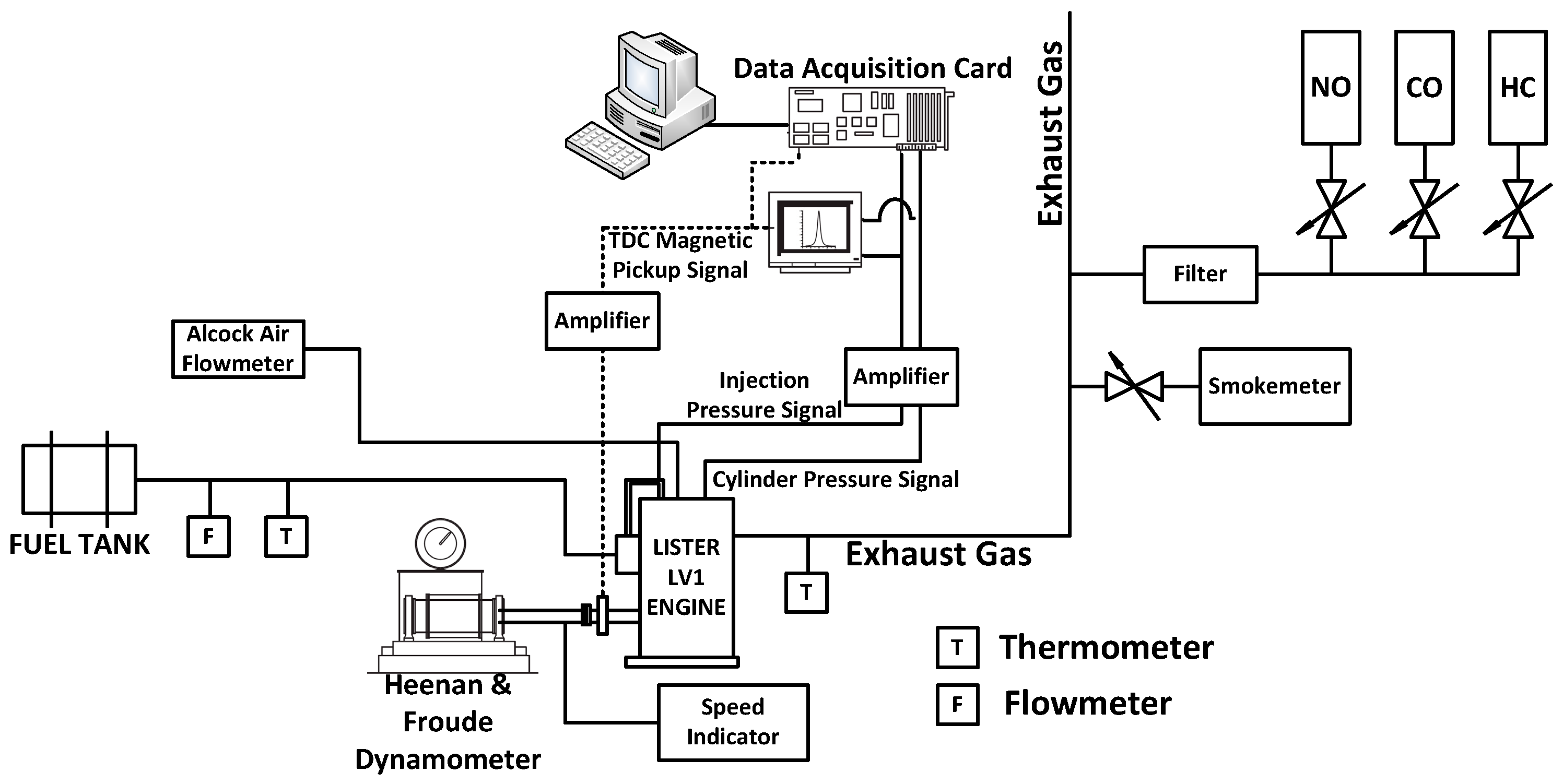
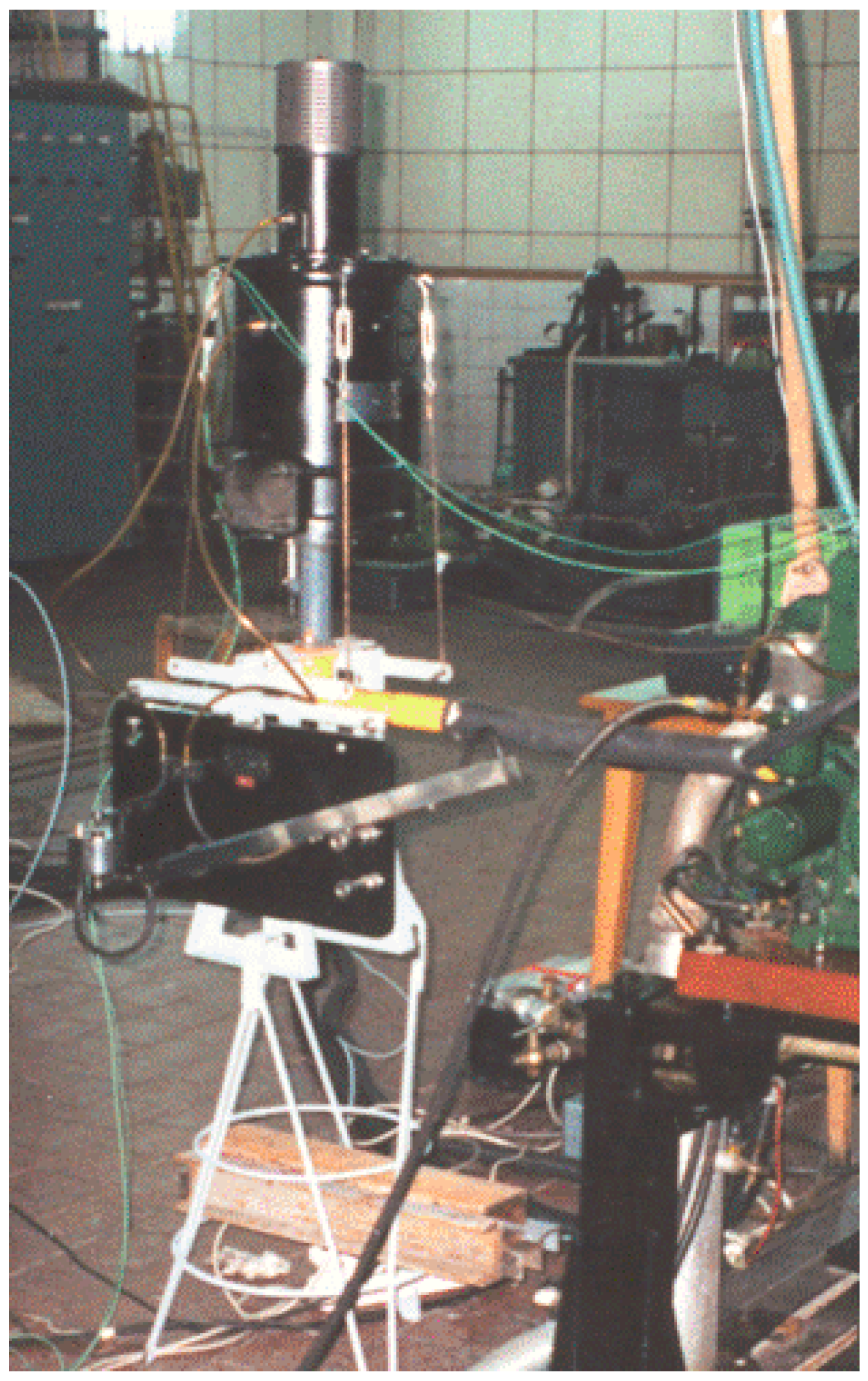
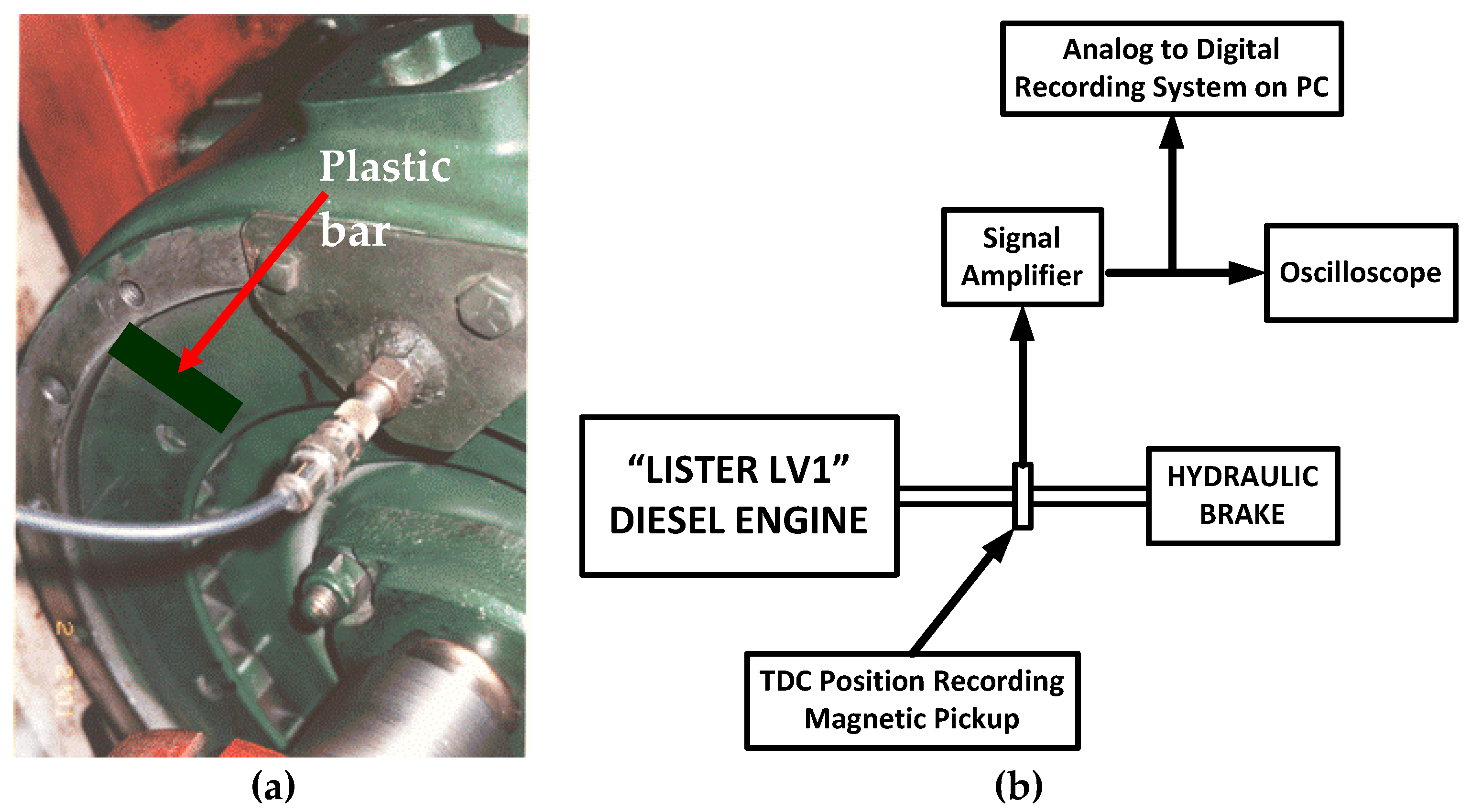
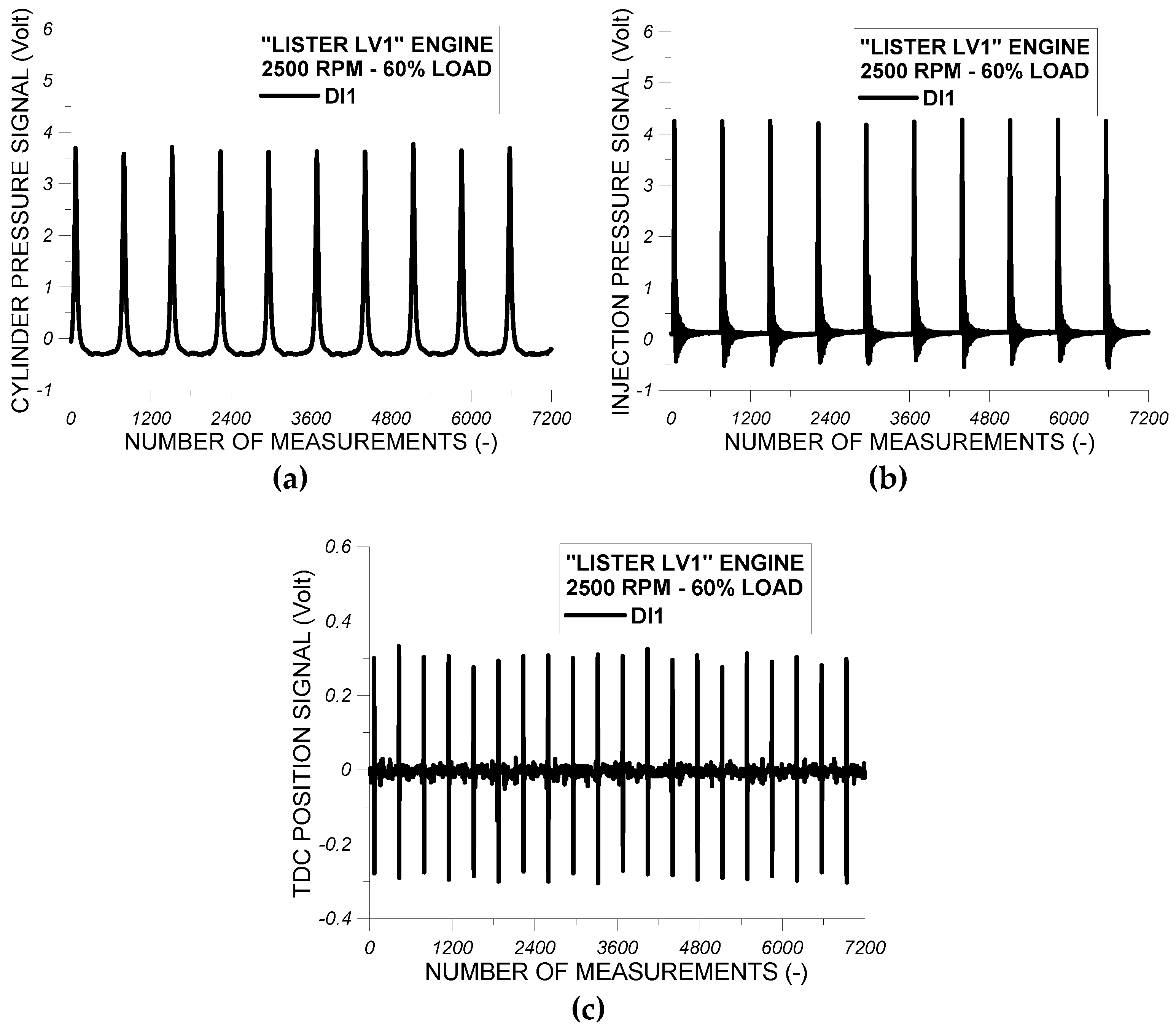
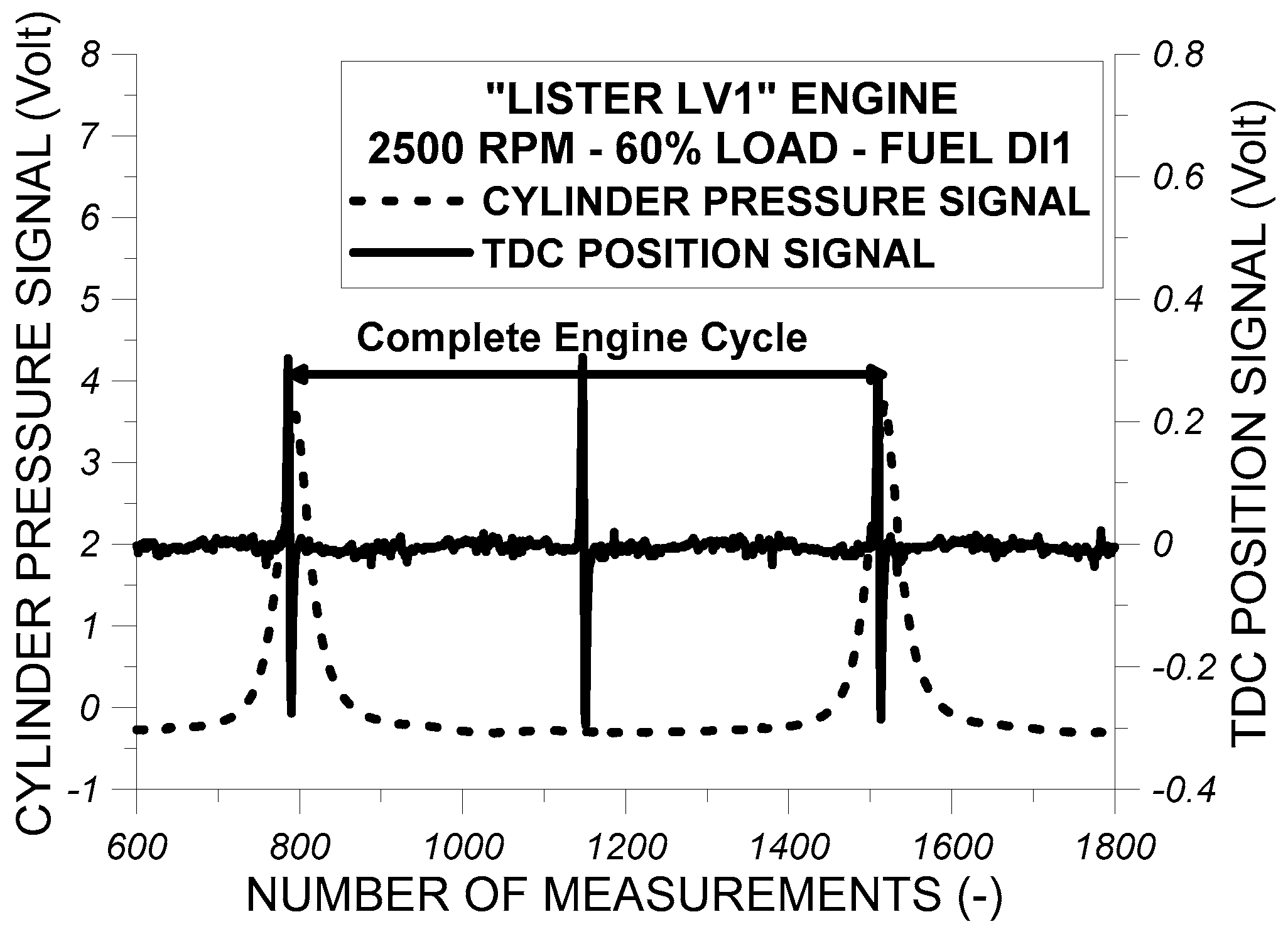
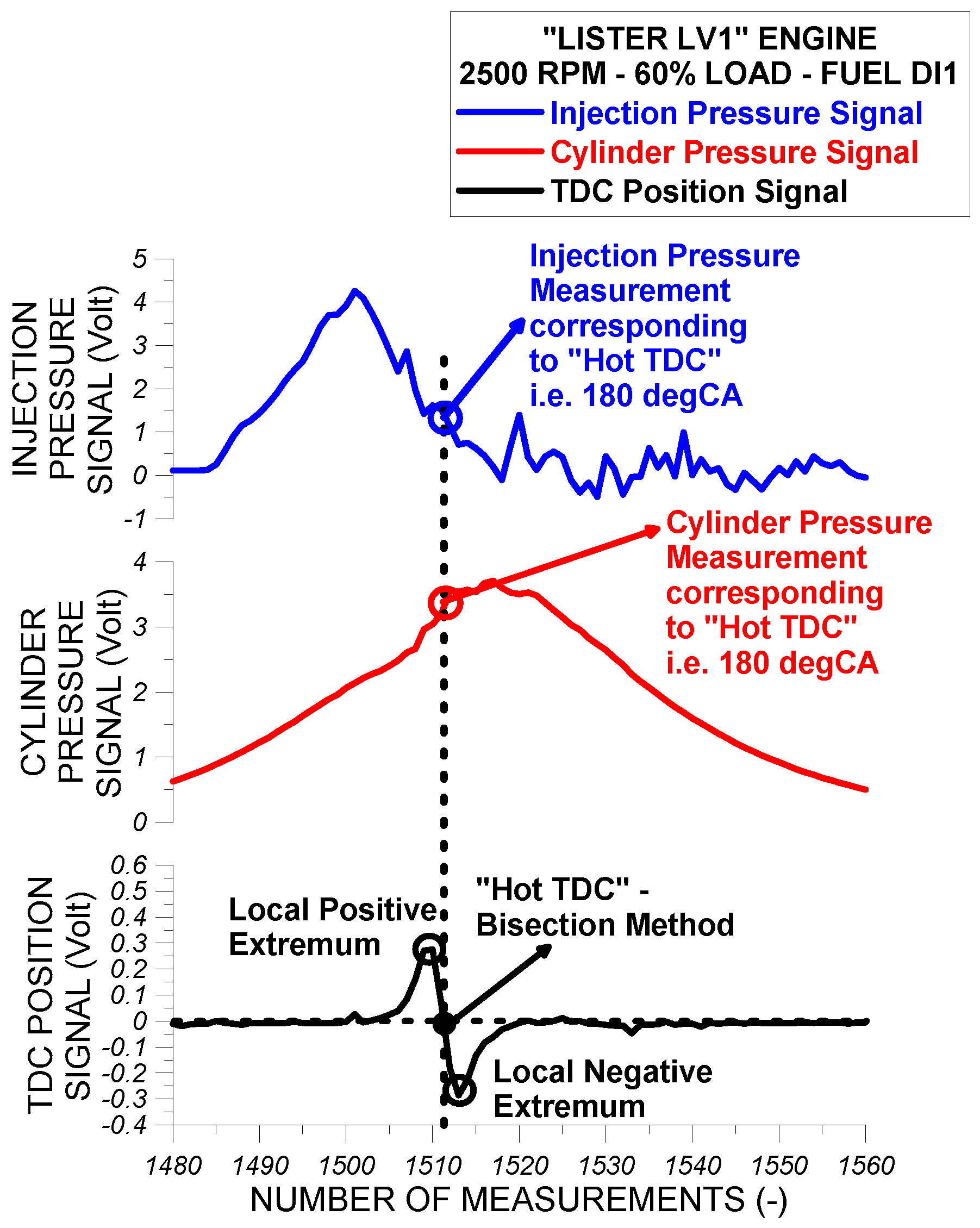
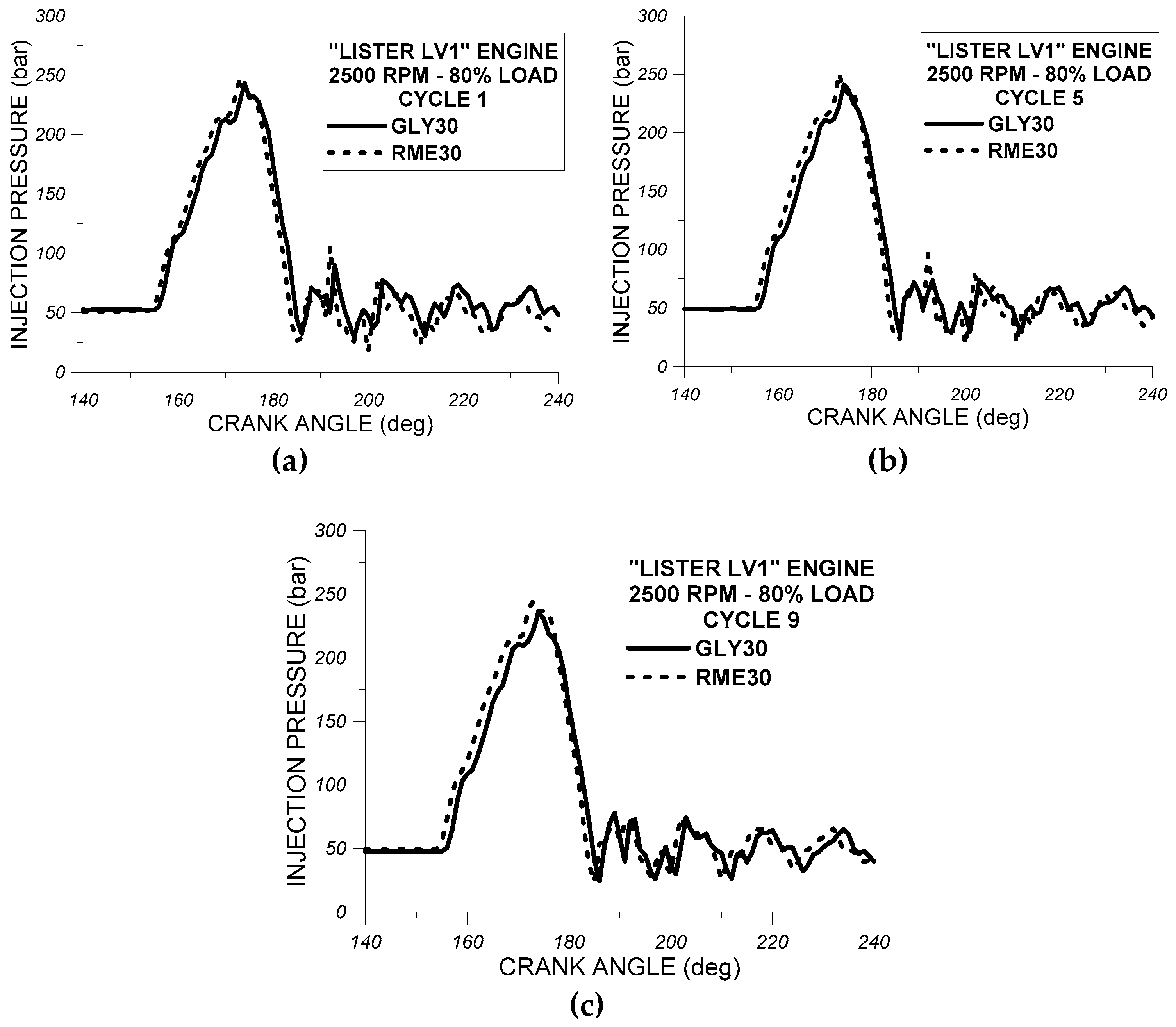
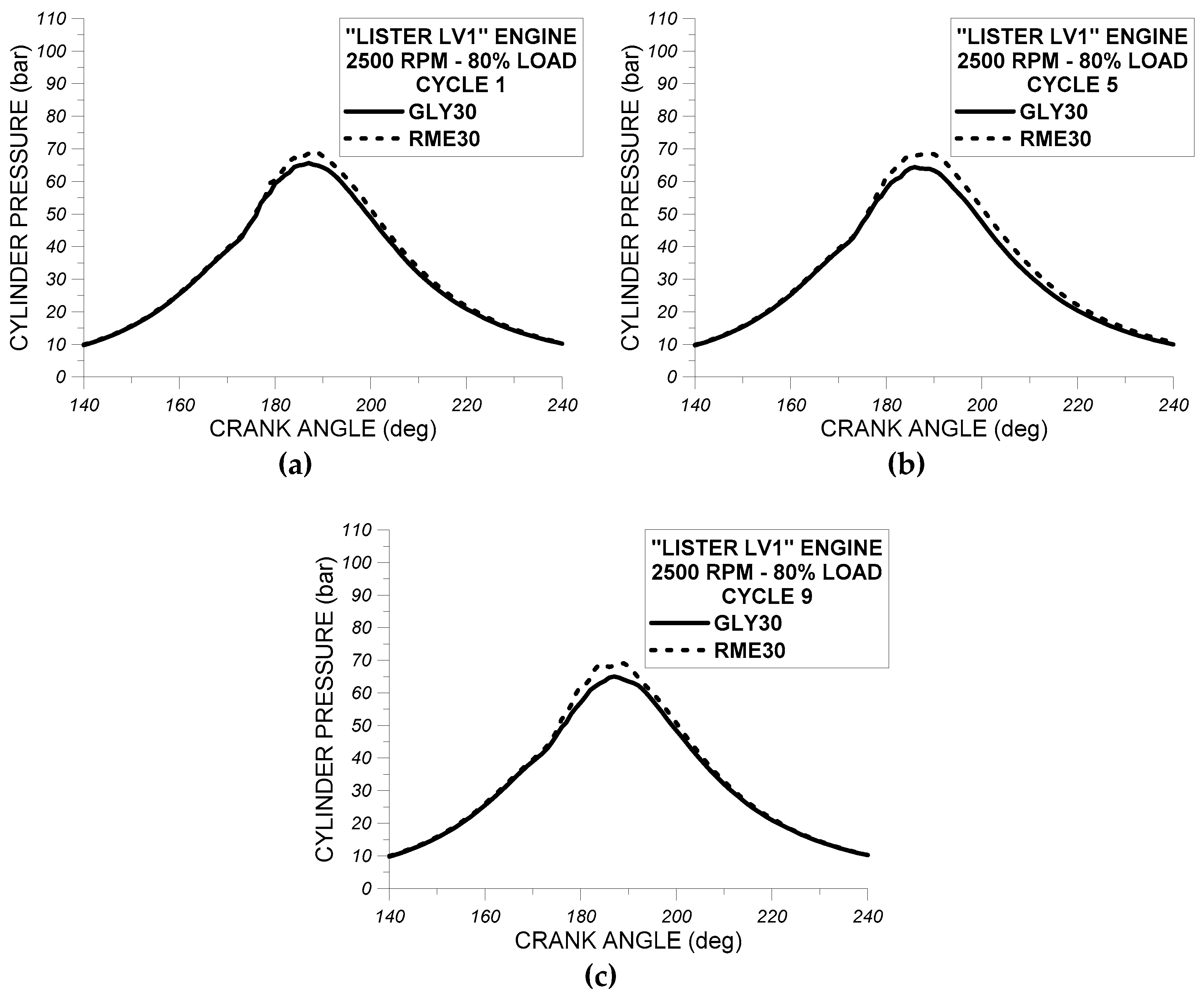
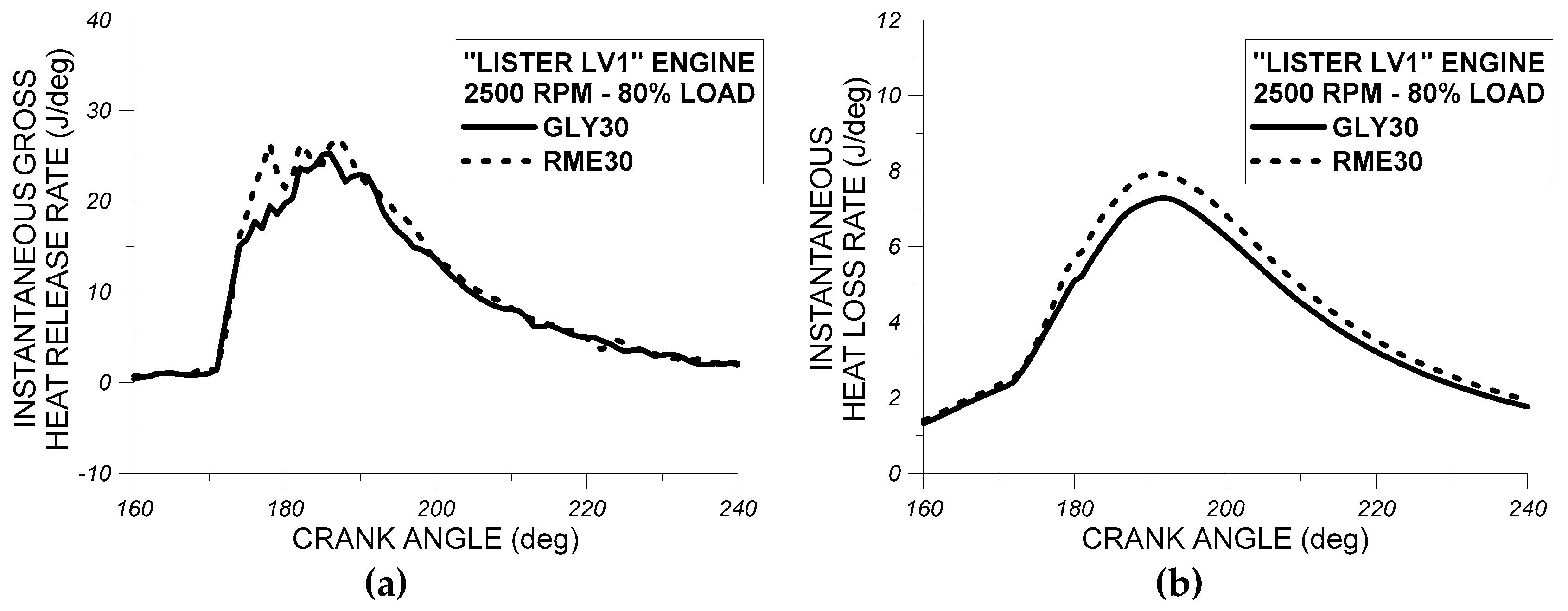
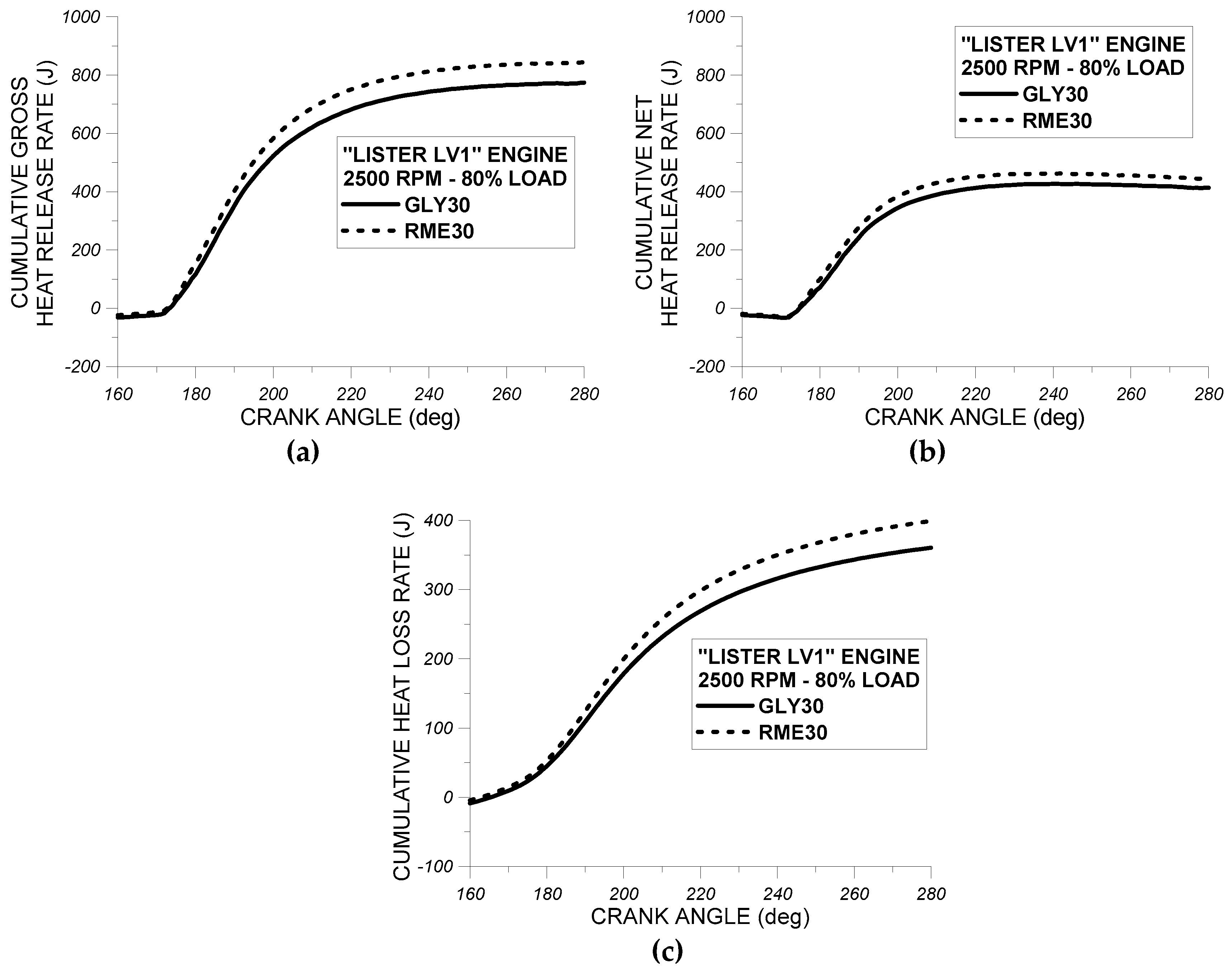
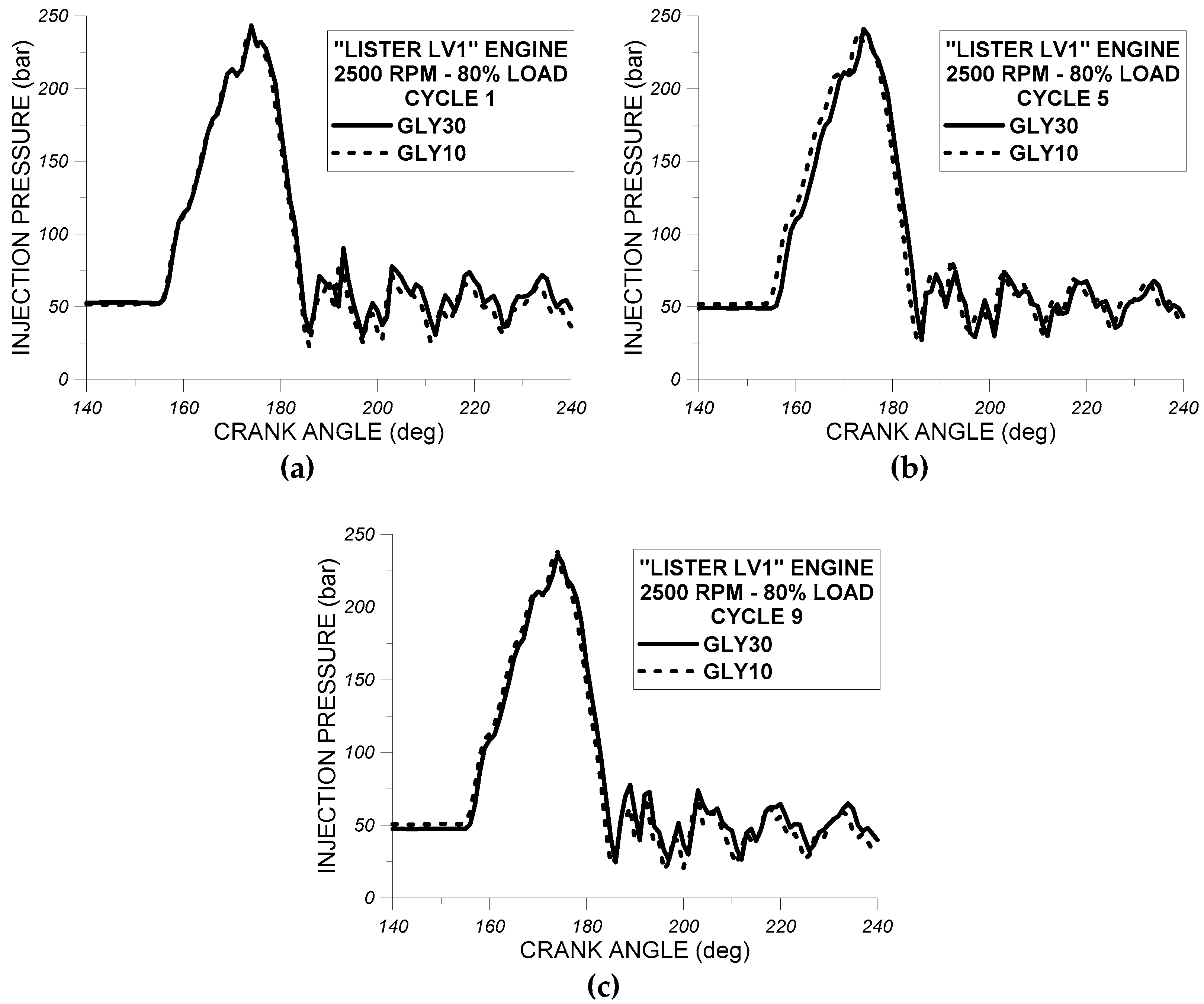
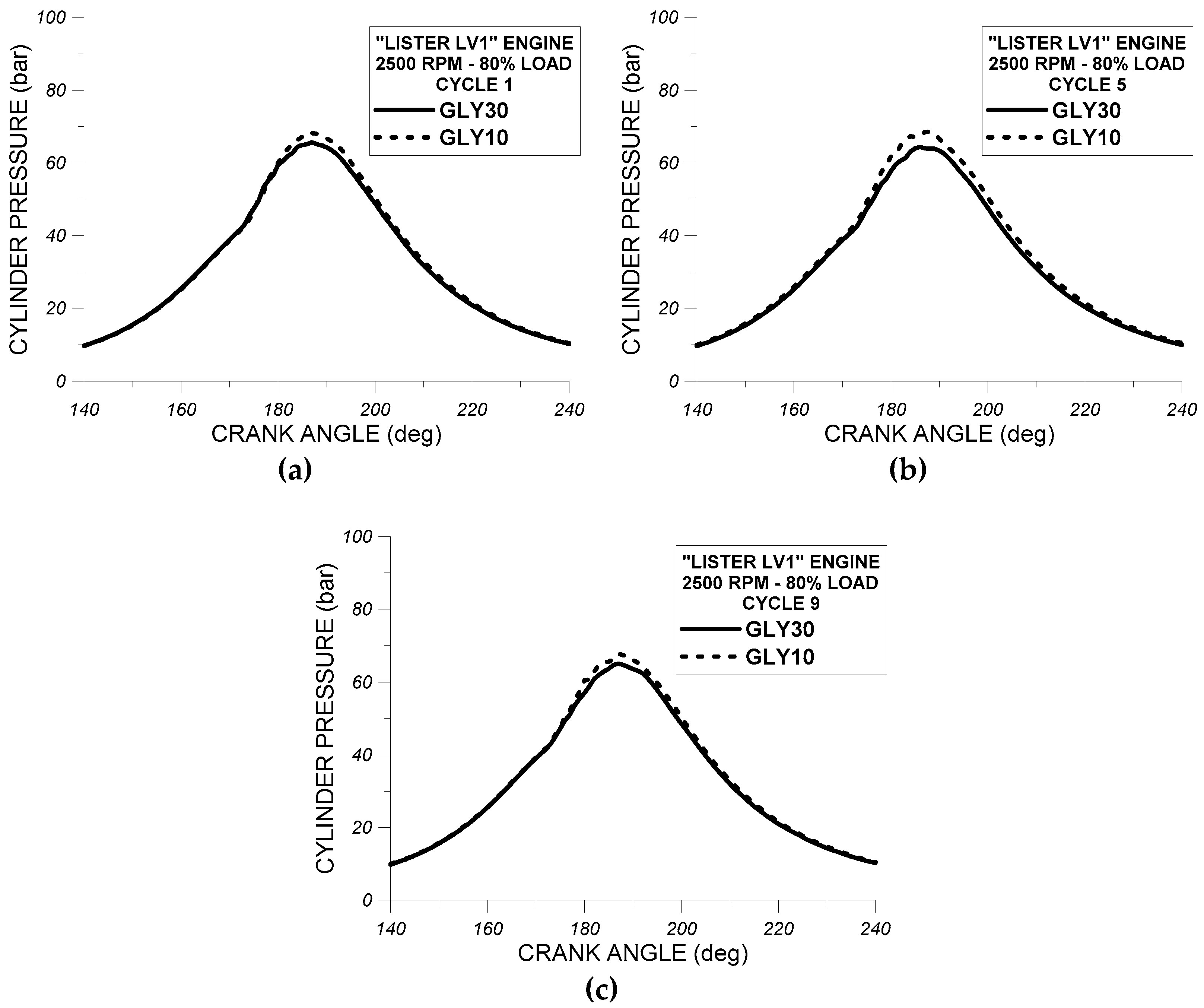
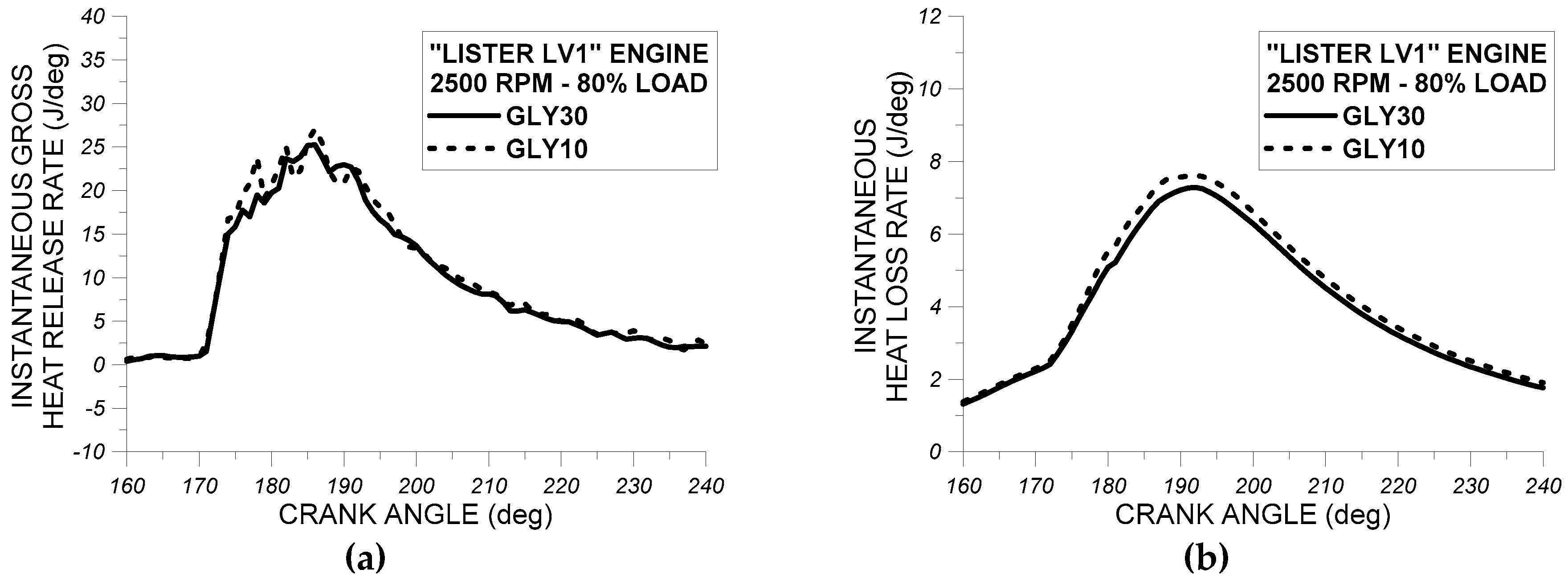
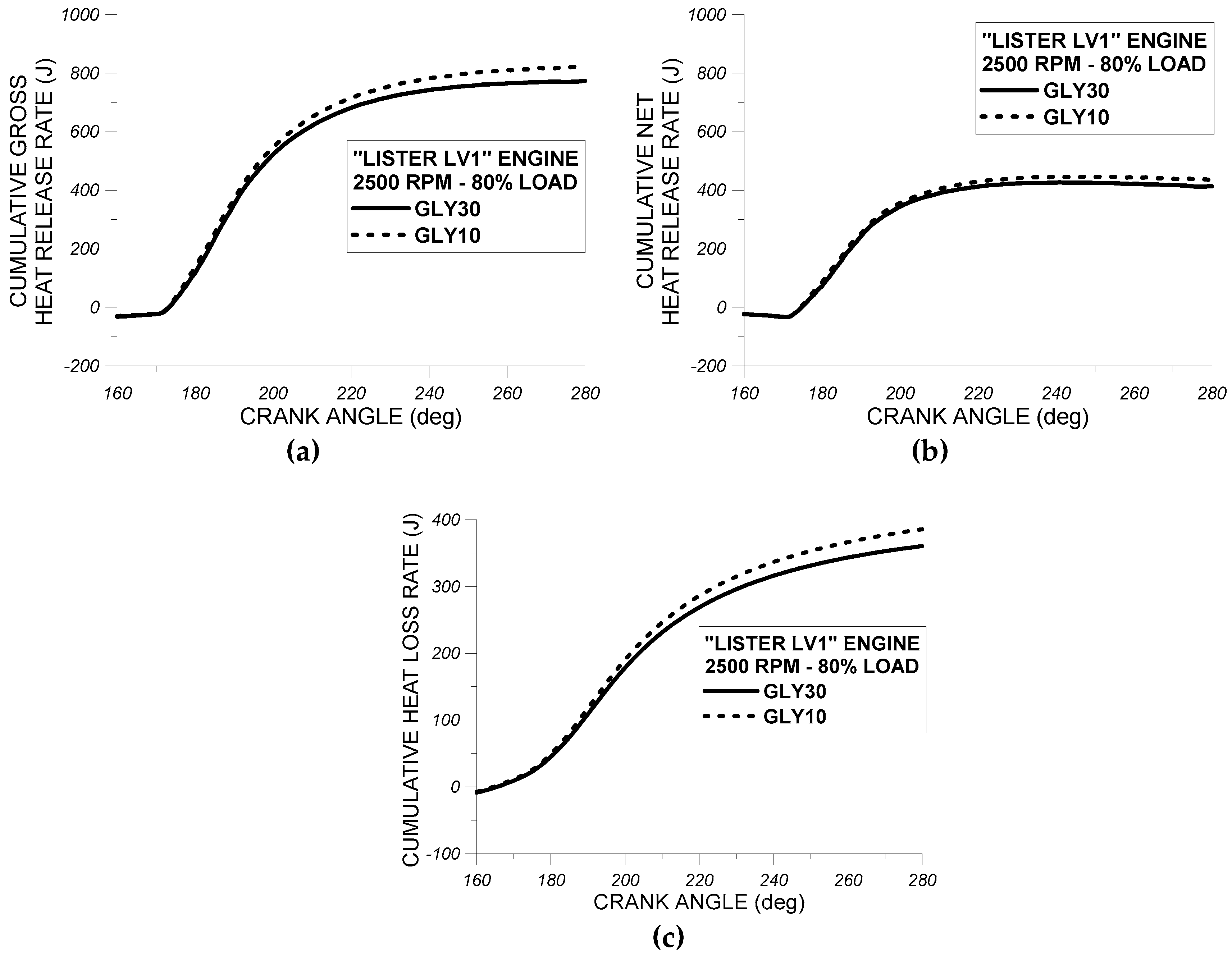

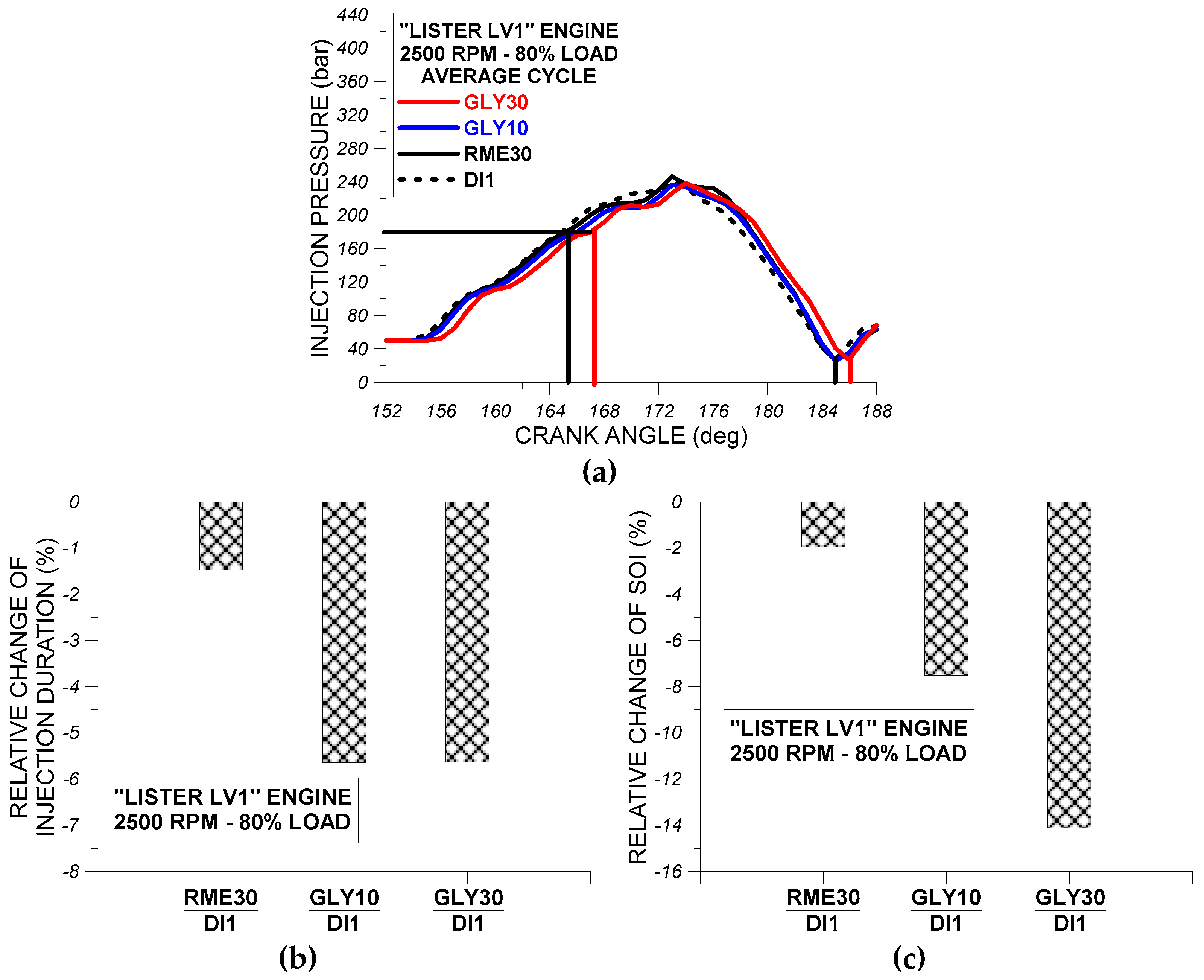
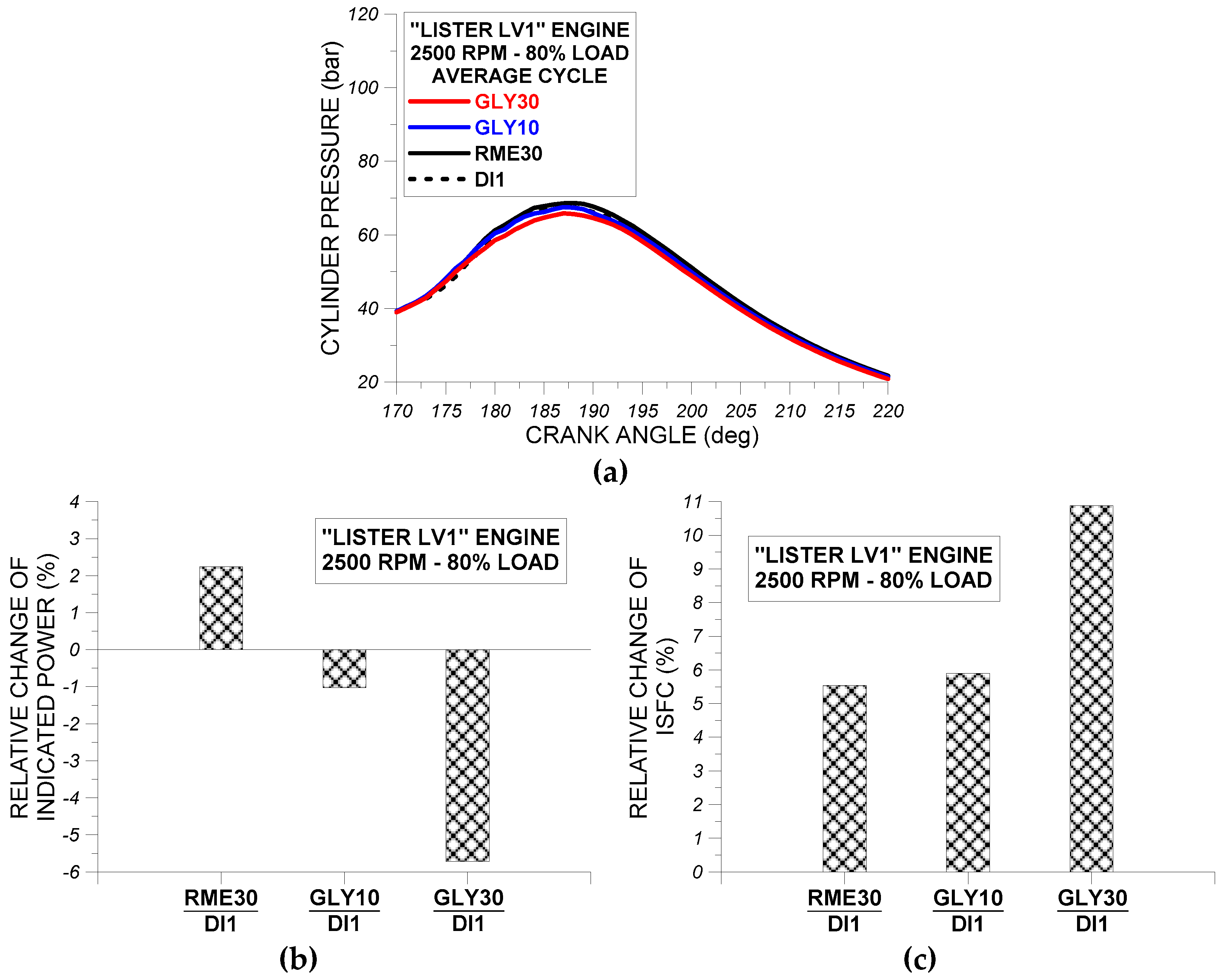
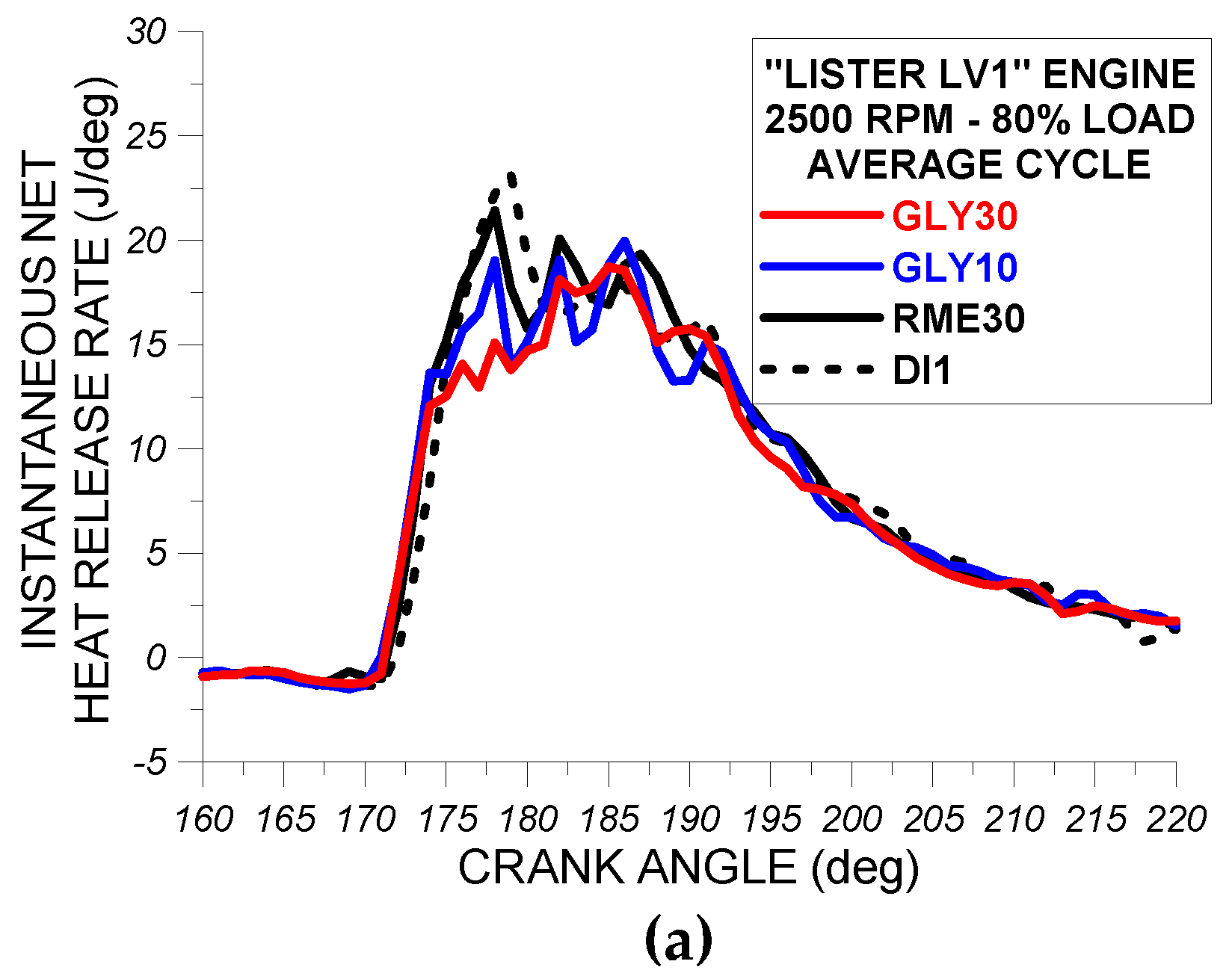
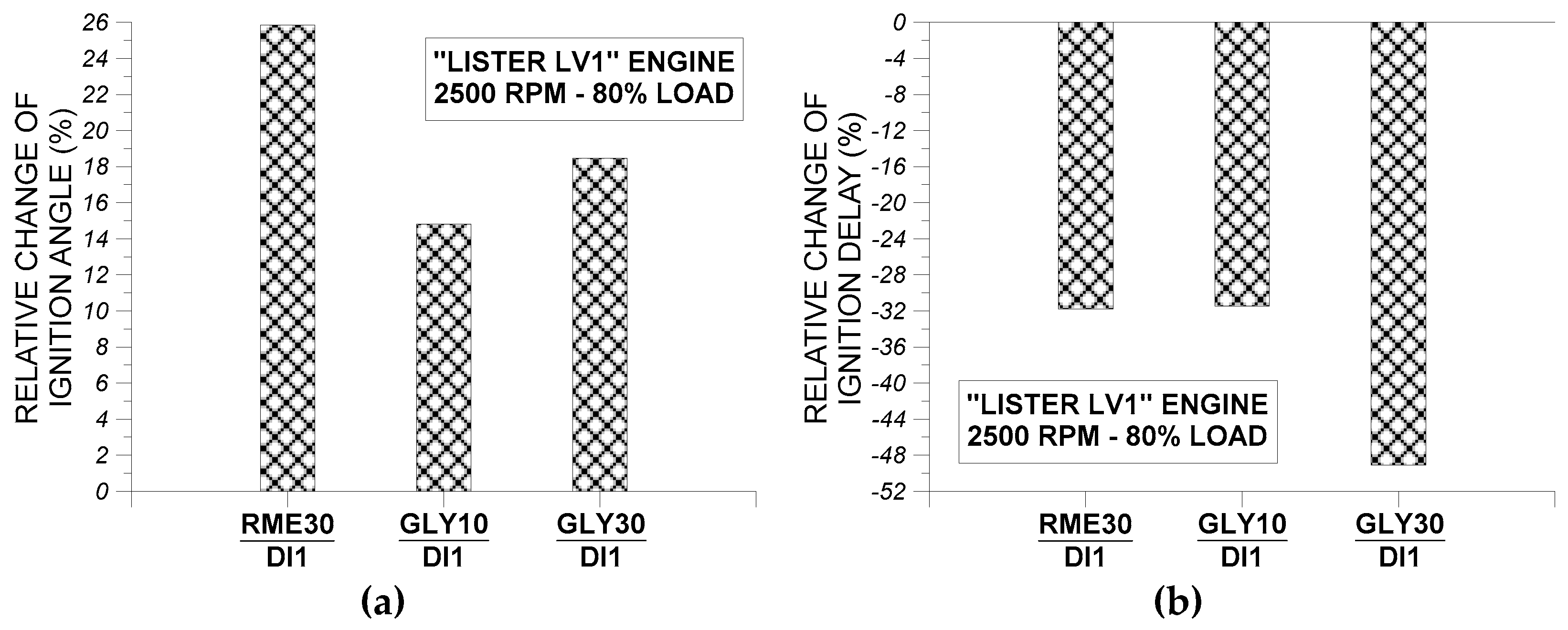
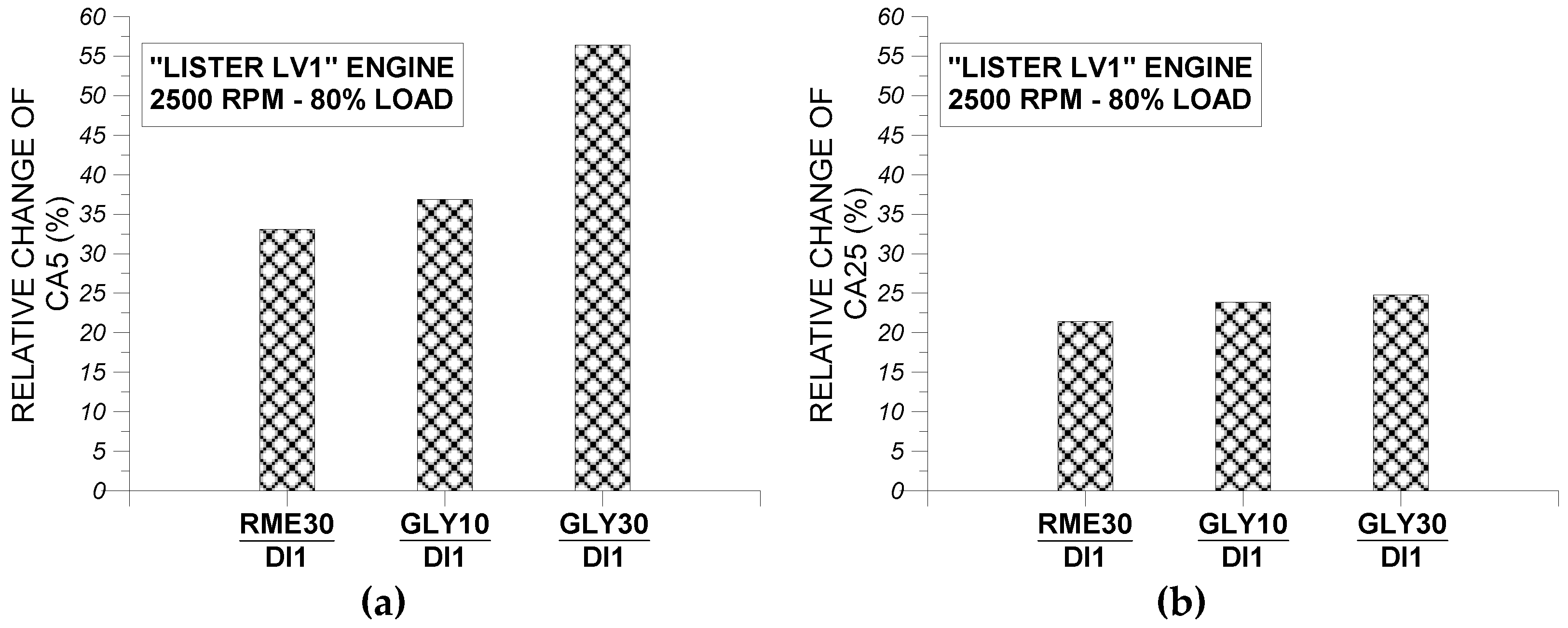
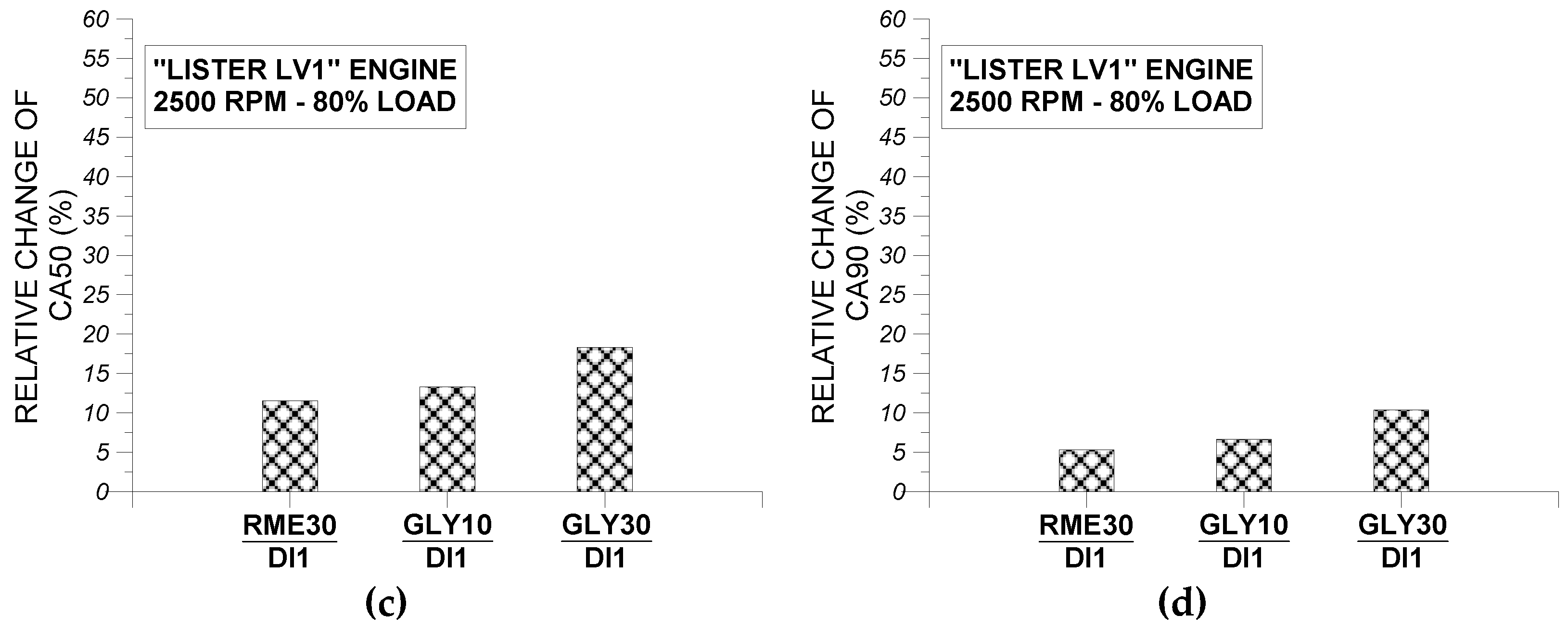
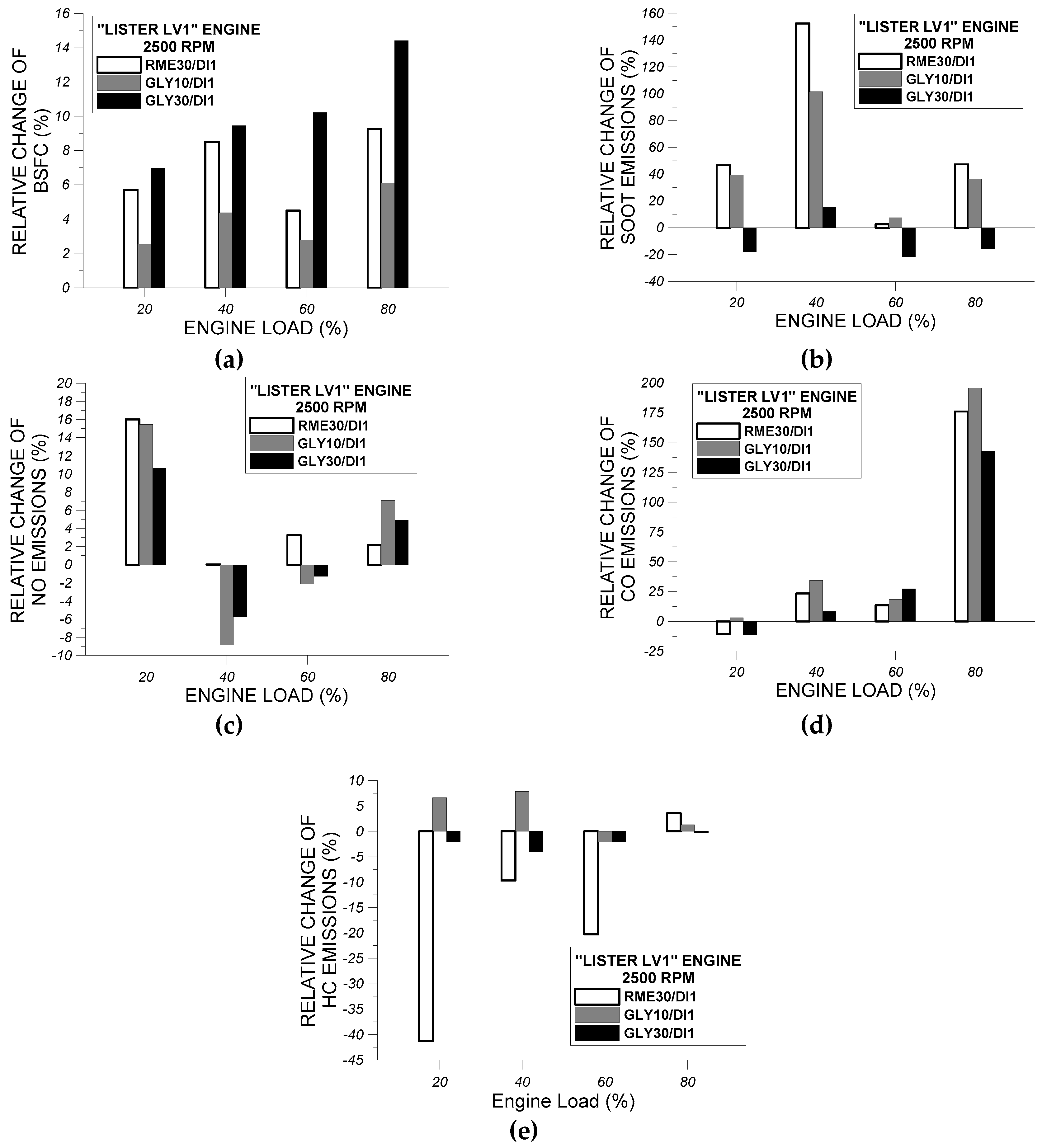
| Fuel | Method | DI1 | RME30 | GLY10 | GLY30 |
|---|---|---|---|---|---|
| Description | “Base” fuel | DI1 + RME 3% oxygen | DI1 + Glymes 3% oxygen | DI1 + Glymes 9% oxygen | |
| Fuel Recipe | Finnish summer grade city diesel | 70 mass-% DI1 30 mass-% RME | 90.7 mass-% DI1 5.0 mass-% Diglyme 4.3 mass- % Butyl Diglyme | 71.4 mass-% DI1 15.0 mass-% Diglyme 13.6 mass-% Butyl Diglyme | |
| Paraffines, mass-% | ASTM D2425 | 40.1 | 28.1 | 36.4 | 28.6 |
| Naphtenics, mass-% | ASTM D2425 | 40.1 | 28.1 | 36.4 | 28.6 |
| Aromatics, mass-% | ASTM D2549 | 19.8 | 13.9 | 18.0 | 14.1 |
| Density, 15 °C, kg/m3 | ISO 3675 | 833.7 | 848.2 | 840.5 | 854.9 |
| Distillation, °C, 5% | ISO 3405 | 208.0 | 221.5 | 192.9 | 175.2 |
| Distillation, °C, 50% | ISO 3405 | 270.2 | 307.3 | 265.3 | 254.6 |
| Distillation, °C, 95% | ISO 3405 | 347.9 | 350.6 | 348.8 | 345.2 |
| Cetane number | ISO 5165 | 53.3 | 54.2 | 59.5 | 72.7 |
| Viscosity +40 °C, mm2/s | ISO 3104 | 2.94 | 3.27 | 2.54 | 1.99 |
| LHV, MJ/kg | ISO 1928 | 43.03 | 41.22 | 41.48 | 38.75 |
| Compressibility, 60 bar, 20 °C, [× 10−5 bar−1] | FEV | 6.81 | 6.56 | 6.87 | 6.98 |
| Sulphur, mg/kg | ISO 8754 / D3210 | 31 | 23 | 28 | 23 |
| Diglyme, mass-% | GC-AED | 0 | 0 | 5.5 | 16.6 |
| Butyl Diglyme, mass-% | GC-AED | 0 | 0 | 4.7 | 14.7 |
| Glymes, mass-% | Calc. | 0 | 0 | 10.2 | 31.3 |
| RME Content | GC-AED | 0 | 31.2 | 0 | 0 |
| Carbon, % | ASTM D5291 | 86.1 | 83.0 | 83.2 | 78.1 |
| Hydrogen, % | ASTM D5291 | 14.0 | 13.3 | 13.6 | 13.2 |
| C/H ratio | ASTM D5291 | 6.1 | 6.20 | 6.10 | 5.94 |
| Oxygen content | Calc. | 0 | 3 | 3 | 9 |
| Technical Specification | Definition |
|---|---|
| Number of cylinders | 1 |
| Engine operation type | Four-stroke |
| Air breathing type | Naturally aspirated |
| Cooling method | Air cooled |
| Combustion chamber | Direct injection—“Bowl-in-piston” |
| Cylinder bore | 85.73 mm |
| Piston stroke | 82.55 mm |
| Connecting rod length | 188.5 mm |
| Compression ratio | 17:1 |
| Nominal speed range | 1000–3000 RPM |
| Maximum power | 6.7 kW @ 3000 RPM |
| Maximum torque | 25 Nm @ 2000 RPM |
| Number of fuel injector holes | 3 |
| Nozzle orifice diameter | 0.250 mm |
| Injector opening pressure | 180 bar |
| Number of valves per cylinder | 2 |
| Intake valve opening | 15 degCA BTDC |
| Intake valve closing | 41 degCA ABDC |
| Exhaust valve opening | 41 degCA BBDC |
| Exhaust valve closing | 15 degCA ATDC |
| Engine Speed (RPM) | Laboratory Barometric Pressure (mmHg) | Laboratory Relative Humidity (%) | Laboratory Dry Air Temperature (oC) | Hydraulic Dynamometer Load (kg) | Engine Power (kW) | Engine Load (%) | Lubricant Oil System Pressure (bar) |
|---|---|---|---|---|---|---|---|
| 2500 | 771.8 | 58.5 | 26.2 | 1 | 1.23 | 20 | 0.7–1 |
| 770.6 | 57 | 27.5 | 2 | 2.45 | 40 | 0.7–1 | |
| 769.5 | 56.5 | 27.8 | 3 | 3.68 | 60 | 0.7–1 | |
| 768 | 56 | 28 | 4 | 4.90 | 80 | 0.7–1 |
| Fuel | Alcock Value (cm) | Intake Air Volume Flow Rate (m3/h) | Intake Air Density (kg/m3) | Intake Air Mass Flow Rate (kg/h) | Measured Time of 50 mL Fuel Consumption (s) | Fuel Consumption (kg/h) |
|---|---|---|---|---|---|---|
| DI1 | 16.8 | 28.53 | 1.197 | 34.159 | 105 | 1.429 |
| RME30 | 16.7 | 28.36 | 1.190 | 33.756 | 99 | 1.542 |
| GLY10 | 16.7 | 28.36 | 1.188 | 33.675 | 101 | 1.498 |
| GLY30 | 16.9 | 28.70 | 1.184 | 33.989 | 103 | 1.494 |
© 2019 by the authors. Licensee MDPI, Basel, Switzerland. This article is an open access article distributed under the terms and conditions of the Creative Commons Attribution (CC BY) license (http://creativecommons.org/licenses/by/4.0/).
Share and Cite
Zannis, T.C.; Papagiannakis, R.G.; Pariotis, E.G.; Kourampas, M.I. Experimental Study of DI Diesel Engine Operational and Environmental Behavior Using Blends of City Diesel with Glycol Ethers and RME. Energies 2019, 12, 1547. https://doi.org/10.3390/en12081547
Zannis TC, Papagiannakis RG, Pariotis EG, Kourampas MI. Experimental Study of DI Diesel Engine Operational and Environmental Behavior Using Blends of City Diesel with Glycol Ethers and RME. Energies. 2019; 12(8):1547. https://doi.org/10.3390/en12081547
Chicago/Turabian StyleZannis, Theodoros C., Roussos G. Papagiannakis, Efthimios G. Pariotis, and Marios I. Kourampas. 2019. "Experimental Study of DI Diesel Engine Operational and Environmental Behavior Using Blends of City Diesel with Glycol Ethers and RME" Energies 12, no. 8: 1547. https://doi.org/10.3390/en12081547
APA StyleZannis, T. C., Papagiannakis, R. G., Pariotis, E. G., & Kourampas, M. I. (2019). Experimental Study of DI Diesel Engine Operational and Environmental Behavior Using Blends of City Diesel with Glycol Ethers and RME. Energies, 12(8), 1547. https://doi.org/10.3390/en12081547






